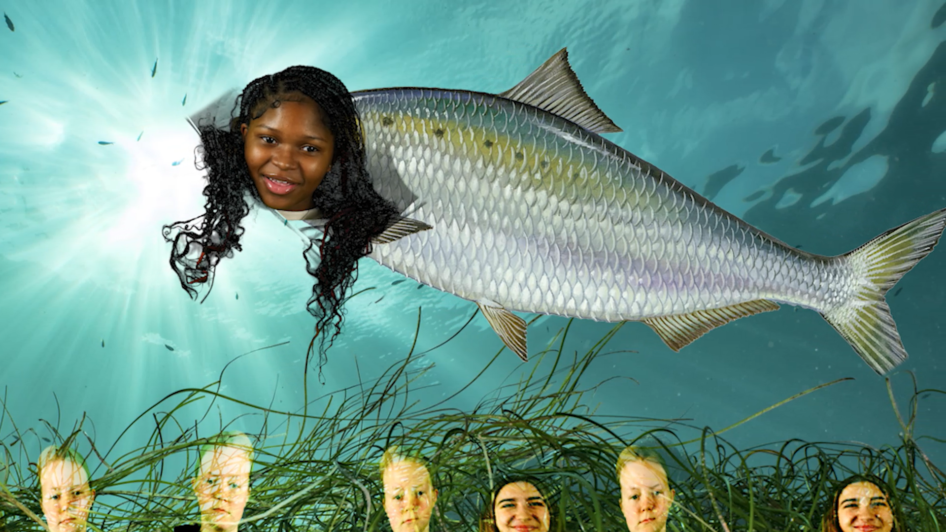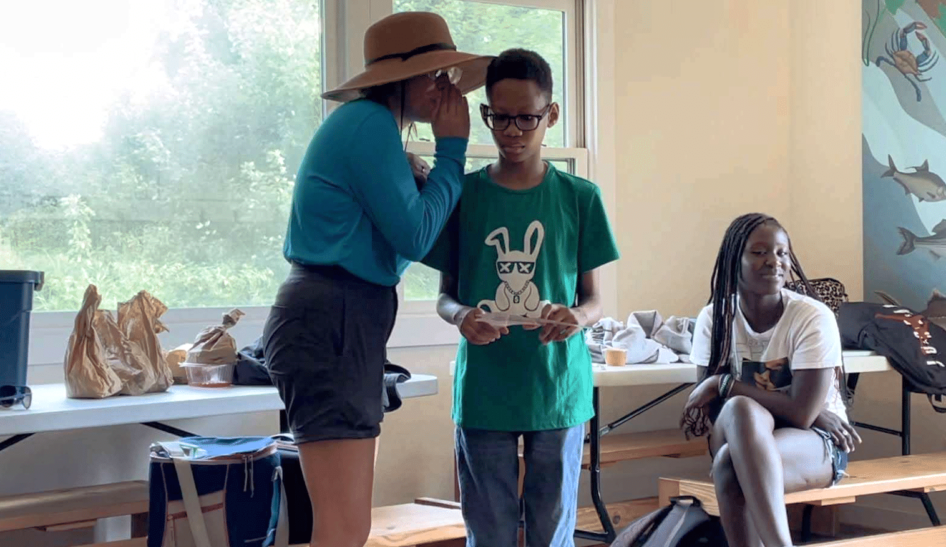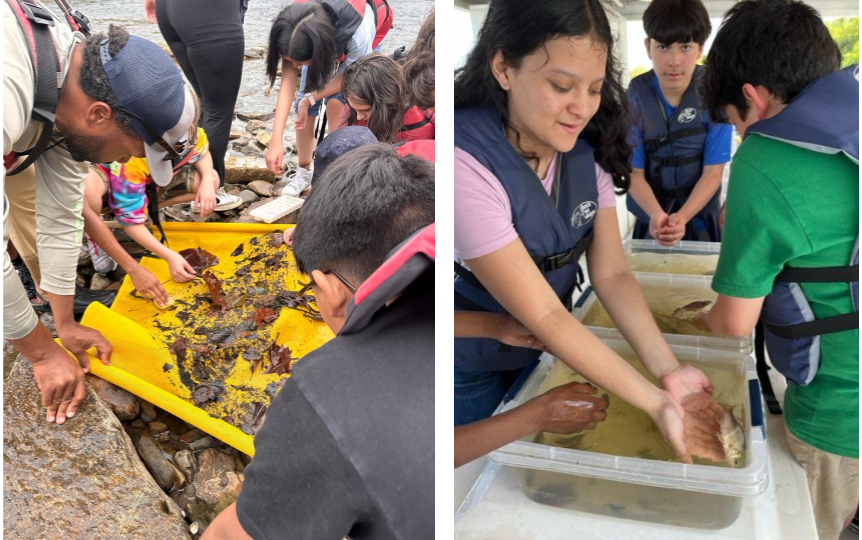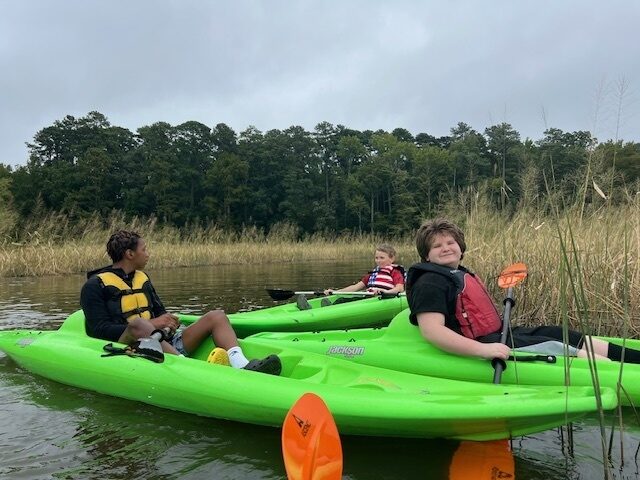From the Mountains to the Bay: Implementing systemic MWEEs across three school systems on the James River

by Matt Scott Stone & Nat Draper, James River Association

The James River Association, Local Partnerships, and Meaningful Watershed Educational Experiences
Over the past three years, the James River Association partnered with three school districts along the James River to help students meaningfully experience their local watershed and answer the big question: “How can we protect aquatic ecosystems in the James River and Chesapeake Bay Watershed?” By engaging in year-long Meaningful Watershed Educational Experiences, or MWEEs, students learn how to define environmental challenges, conduct field investigations, reflect on data to find conclusions, and ultimately develop action plans to address environmental issues in their local communities!
The James River Association (JRA) is a nonprofit with the goal of being a guardian for the James River, America’s founding river. With three offices spanning very different pieces of the James River, the JRA can provide a wide variety of educational experiences for students which focus on local, unique ecosystems and attributes along the river. In the Upper James, JRA’s office abuts a huge cliffside at River Edge Park and overlooks the vista of downtown Lynchburg, Virginia. At the Fall Line, JRA’s headquarters lies in the heart of Richmond, just moments from Class IV urban rapids. JRA’s Lower James office sits nestled near calm tidal waters alongside the Colonial National Parkway. This local focus gives students the opportunity to learn about, understand, and protect the ecosystems that are relevant to where they live and recreate. The wide reach of JRA also plays an important role in partnering with school systems. In 2023, JRA worked with over 20,000 students from 214 schools to bring students outdoors to experience a connection with the James River and its watershed.
Partnerships along the James River
Catalyzed by a NOAA B-WET grant, JRA developed an ambitious plan to introduce MWEEs to 7th grade students in three different school districts that border the James River. In the Upper James, JRA’s Lynchburg team partnered with Monelison and Amherst Middle Schools in Amherst County. Near Richmond, JRA partnered with Carter G. Woodson Middle School, part of Hopewell Public Schools. In the Lower James, the Williamsburg team worked with students from Luther P. Jackson Middle School in Surry County. Over the summer of 2021, JRA worked with 7th grade teachers in these schools to develop a plan to introduce their students to MWEEs over the next three years.
Defining an issue and choosing field experiences
For each school district, teachers and JRA educators chose to investigate a problem local to their unique location on the James. Each school district chose a different representative organism to examine how humans impacted aquatic organisms in the watershed.

In Amherst County, teachers and students chose to investigate impacts of pollution on macroinvertebrate species. Macroinvertebrates in the James River and its tributaries include crawfish, dragonfly nymphs, and bivalves. With JRA educators, students caught and identified these critters to find out whether or not they live in a healthy water system. The students also learned how to paddle canoes and investigated the abiotic water quality of the James with chemical and physical tests.
In Hopewell, students undertook an expedition to Presquile National Wildlife Refuge to investigate the status of the American shad – a declining native species that is historically and culturally important to life along the James River. The Refuge, administered by the U.S. Fish and Wildlife Service (USFWS), is a 1400 acre sanctuary which only admits a few specific groups of people each year. JRA took students to the Refuge on the Spirit of the James, casting a trawl net overboard along their journey. Students pulled up the trawl to count the various species and fish from the bottom of the river. While the students counted dozens of blue catfish (an invasive species), white perch, and even a few blue crabs, not a single American shad was encountered. Students spent the rest of their trip on the island investigating native and invasive land species, and seeing how ecosystems interact both above and below the water.

In Surry, students looked into factors that affect the health of the eastern oyster. Students learned how to pilot a kayak and went out in a tributary of the James to look for oyster beds. On land, they learned about the history of oyster harvesting and how human activities impact the number and health of oysters in the Chesapeake Bay.
Generating conclusions and creating action projects
At the end of their outdoor experiences, students were full of information about the environment of their chosen species. With the data collected from each trip, and research sheets and sources provided by JRA, students decided on the best strategies to tackle problems specific to their region of the James.
JRA educators worked for a week at each school to develop an action project to spread awareness about problems in the James River specific to their set of organisms. Students brainstormed possible public service announcements (PSAs) that would use information gathered from their field experiences to engage the public in a specific action that could affect the health of their chosen organism. Students created messages about sediment pollution, thermal pollution, overfishing, and blockage of migration by dams as part of their PSAs. All in all, over 300 different videos were produced by students who got the chance to be actors, directors, writers, and producers of their own message.
Advocacy
Following the week-long marathon of creating a PSA, a videographer dove deep into the footage to professionally produce the videos for each student team. These videos took student ideas and turned them into unique messages personal to each student team’s experiences. Each school scheduled a community day where students shared their videos with the public, explained their projects, and showcased their hard work.
Looking Forward
JRA worked with partner teachers to develop a plan to create field science bins filled with the tools each class has used over the last three years to support future field experiences. Armed with new turbidity tubes, refractometers, chemical test kits, and fantastically trained teachers, future students will be able to experience a full MWEE, even without the direct help of JRA. After three years of administering trips and helping students work on action projects, the teachers who supported these projects will have all the tools they need to create their own spin on a MWEE, educating class after class about how students can protect aquatic ecosystems.
